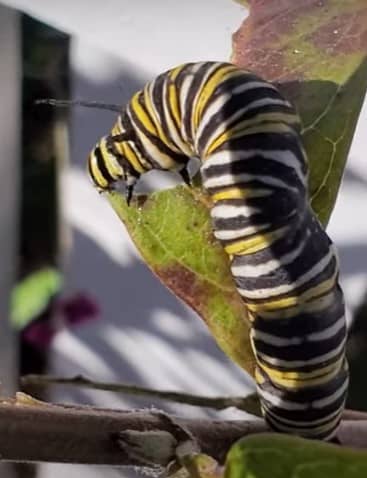The monarch caterpillars are famous for their bright stripes, which help to deter predators. They also have an interesting anatomy that makes them unique from other caterpillar species.
The monarch caterpillar has six legs, like all caterpillars, and these are situated in the front section of the body. The legs are attached to the thorax, which is the middle section of the body. The thorax is also where the caterpillar’s three pairs of true legs are located, along with the prolegs. The prolegs are fleshy, suction cup-like structures that help the caterpillar to grip onto surfaces as it crawls.
The head of the monarch caterpillar is located at the front of the body, and it has a pair of large, black mandibles that are used for biting and chewing. The caterpillar’s eyes are located on the sides of its head, and it has simple eyes that can detect light and dark. The monarch caterpillar also has a pair of sensory antennae that help it to detect its surroundings.
One of the most distinctive features of the monarch caterpillar’s anatomy is its spiracles. Spiracles are small holes that are located along the sides of the caterpillar’s body, and they are used for respiration. The monarch caterpillar has ten pairs of spiracles, with two pairs on each segment of the abdomen. These spiracles allow the caterpillar to breathe, as well as to expel waste gases from its body.
The monarch caterpillar’s body is divided into three main sections: the head, thorax, and abdomen. The head and thorax are covered in a tough, protective exoskeleton that helps to protect the caterpillar from predators. The abdomen is covered in soft, flexible skin that allows the caterpillar to expand and grow as it feeds.
The monarch caterpillar also has a complex digestive system. Like all caterpillars, it has a long, coiled gut that runs the length of its body. The gut is divided into several sections, including the foregut, midgut, and hindgut. The foregut is where the caterpillar’s mandibles crush and grind up its food, while the midgut is where most of the digestion and nutrient absorption takes place. The hindgut is where waste materials are stored before they are expelled from the caterpillar’s body.
One of the most interesting aspects of the monarch caterpillar’s anatomy is its ability to store and sequester toxic compounds. Monarch caterpillars feed exclusively on milkweed plants, which contain toxic compounds called cardiac glycosides. These compounds are poisonous to many animals, but the monarch caterpillar has evolved a unique defense mechanism that allows it to store and use these toxins to its advantage.
When the monarch caterpillar feeds on milkweed plants, it stores the cardiac glycosides in its body, making itself toxic to predators. This toxicity is carried over into the adult butterfly stage, which also feeds on milkweed plants and becomes toxic to predators as a result.


